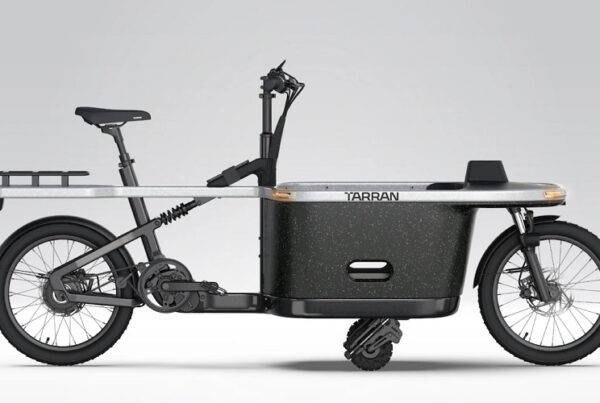Some links may be affiliate links. We may get paid if you buy something or take an action after clicking one of these.
Best Fat Tire Electric Bikes 2021: Overview
*Electric Bike Report aims to help consumers find the right electric bike for their needs. When you buy a product we recommend, we may earn a commission.
Fat-tire electric bikes are a dime a dozen nowadays, but which are the best?
From stable and user-friendly bike path cruisers to high powered bruisers built for hunting and heavy off-road use, e-bikes with fat tires are having a bit of a moment right now. Whatever your reason for wanting a fat e-bike, the Electric Bike Report staff of experts and bike geeks have tested some of the best money can buy.
Birthed from Alaskan snow and New Mexican sand, the ancestors of modern fat bikes first came about in the 90’s as a means to explore (and race) in terrain unkind to your typical bicycle tire. Think mud, deep sand and soft snow. They’ve had high-points of popularity in recent years, but it wasn’t until the rise of the electric bike that we saw the masses rolling around on fat tires. Motors made the heavy, relatively inefficient bikes more friendly to ride and people seem to like the big tires because they give you a feeling of confidence and stability — not to mention many think they just look cool. Their popularity has exploded, and fat tires have been adopted into nearly every category of e-bike.
So which is the best fat-tire electric bike for you? That’s a tough question with an answer that differs from person to person. We’ve compiled this list of fat-ebikes to help you suss out the best fat-tire bike based on your specific needs. You’ll likely notice this list is almost entirely made of full-sized fat e-bikes, so if you’re looking for a more miniature or folding variation, check out our folding e-bike best list.
Our Best Fat-tire Electric Bikes for 2021
How we picked these bikes
This list is a mix of bikes we’ve tested on our home roads and paths of southwest Utah and other e-bikes we’re including on merit alone or because so many of our readers have raved about them. The bikes we’ve reviewed have been put through a rigorous gauntlet of testing meant to paint a picture of how they accelerate, brake, handle and climb hills in the real world. We also put them through a series of range tests to answer the all-important question of how far you can ride them on a single charge.
To make this list, we evaluated the best fat-tire e-bikes based on a few key criteria. Mainly:
- Range: It takes a lot of power to spin tires this big, so does the bike have a battery to back up its tread? There’s a reason fat bikes saw a boom in popularity after e-bikes came around. Simply put, they’re inefficient and not super pleasant to pedal without at least a little assistance. Bikes that make this list need to have batteries that will last.
- Quality and affordability: This category of e-bike in particular is flush with affordable e-bikes designed to maximize performance without draining your wallet. It’s also a category where we see lots of first-time buyers. So what are you getting for your money and is it built to last?
- Speed and power: Fat bikes are the brutes of the e-bike world. They typically have some of the larger motors among their peers, and all that power raises some important questions: Exactly how fast can the bike go and what does that power feel like when you’re riding? Is it delivered in a safe and measured way or does the bike leap from underneath you?
- Comfort and efficiency: Because of their sheer size and the weight of their tires, fat e-bikes run the risk of being uncomfortable or downright difficult to ride. These bikes need to have balanced handling, geometry that’s comfortable but pedaling-friendly and a motor strong enough to keep everything rolling.
- Usefulness: Do the fat tires add something to the bike other than looks? Fat tires can do lots of things to a bike, both good and bad. In our opinion, the best fat-tire e-bike needs to be more stable, more capable or more comfortable.
This is by no means an exhaustive list of the best fat-tire e-bikes. Considering how many of them there are out there, a comprehensive list of that sort would be very, very long. What this list is, is a compilation of the best bikes we’ve tested and bikes we’ve heard about non-stop from our readers, but haven’t gotten to swing a leg over yet. Know of a bike you think should be on this list? Shout it out to us.
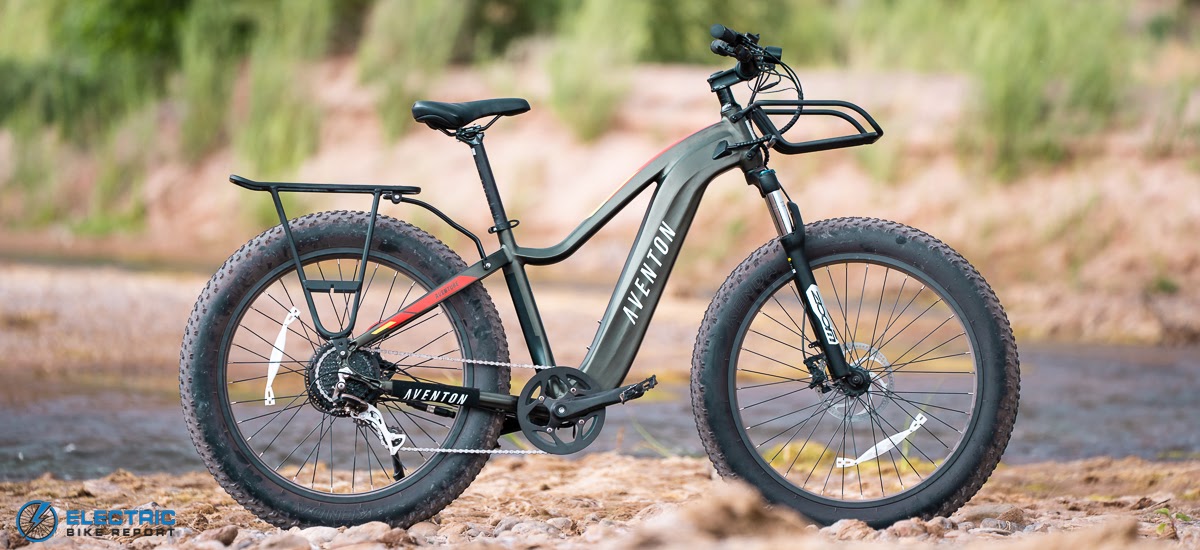
It’s all about the details
Check Best Price | Read Full Review | Watch Our Video Review
A disruptive newcomer to the fat-tire e-bike world, the Aventon Aventure sets a new high bar for what consumers can expect from a sub-$2,000 electric fat bike.
It’s not just the 750W Bafang rear hub motor or the 720Wh fully-integrated battery that have us so enamoured with this electric fatty, it’s also that Aventon managed to chock it full of little features and extras that you just don’t see on many bikes in this category. It’s got a full-color LCD display, metal fenders, a full Shimano Acera drivetrain, hydraulic brakes and, to top it all off, it’s just a really nice riding bike. The handling is sporty without being overly athletic and, though it is a bit heavy, it handles light singletrack surprisingly well.
The Aventure ships as a Class 2 e-bike, but like most of the bikes on this list it’s easily convertible to Class 3, which gives it a top pedal-assisted speed of 28 mph. We’ve tested and even compared this bike head-to-head against some of its biggest competitors, and the results don’t lie: It’s a new breed of affordable electric fat bike.
To put it short, we’re really big fans of the Aventure and we think you would be too.
- Unlocked to Class 3, this is an extremely fast and torquey e-bike
- The full-color LCD display is great and features a percentage based battery readout
- The 720Wh battery is on the larger end of what we see on bikes in this category
- It’s got a unique styling for a fat e-bike that reminds us of another Aventon we really liked, the Level.
- At 74.27lbs (we reviewed a medium with the optional front and rear racks), the Aventure is slightly heavier than many of its peers.
Rad Power Bikes RadRover 5

Smooth and predictable power
Check Best Price | Read Full Review | Watch Our Video Review
In a category of e-bike that’s often singularly-focused on speed and raw power, the Rad Power Bikes RadRover 5 takes a different, more measured approach. It’s got a 750W rear hub motor that’s very similar to what you’ll find on many other bikes on this list, but the power delivery from that motor is much more gentle, particularly at low speeds.
What this does is give the bike a very predictable and controllable power delivery that’s friendly to new riders or those who want a bike that’s easy to ride. And though the power delivery may be gentler, the rear hub motor should not be underestimated — it’s got more than enough oomph to flatten virtually any hill and get around quickly and easily. The bike is also very well spec’d, with a Shimano Altus drivetrain, mechanical Tektro Aries disc brakes and lights and fenders included, it’s a great value buy.
This is Rad’s fifth iteration of the RadRover, and it’s clear the company has learned a thing or two about what makes a contender for the best fat-tire e-bike. The EBR staff has put hundreds of miles on our test Rover, and it’s proven dependable, fun and overall just feels very refined. The RadRover 5 is a Class 2 e-bike with a throttle and pedal assistance to 20 mph, but that can be changed to a Class 3 setting if you’re looking for a higher cruising speed.
If you want easily-controllable power from a bike that’s backed by an industry-leading e-bike company, the Rad Power Bikes RadRover 5 may be the best choice for you.
- Some bikes with large 750 motors seem to blow you off the starting line, but the power is controlled here to keep it powerful, yet safe.
- The RadRover 5 has predictable motor engagement thanks to a finely-tuned cadence sensor.
- The Saddle and Grips are comfortable for a long period of time. They also match the theme of the bike nicely.
- We really appreciate the wattage readout. Not many affordable bikes include that on their LCD displays, but being able to see it helps you better gauge how much you’re using up the battery in a given level of assist.
- We would have preferred the shifter to be underneath the handlebar, as the location feels more natural. The over the bar shift lever is harder to click on the fly, and less likely to give you a smooth shift.
- The imitation leather grips are a great shape, but they’re a bit slick with sweaty hands.
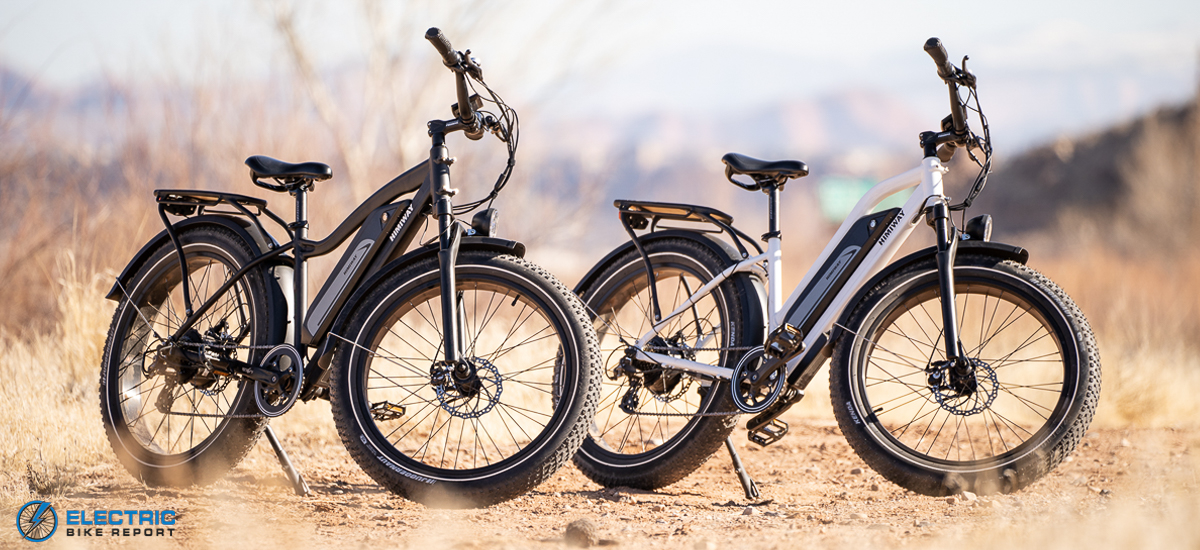
Unbridled power in a cushy, affordable package
Check Best Price | Read Full Review | Watch Our Video Review
If any bike on this list has earned a cult following, it’s the Himiway Cruiser.
Loved for its sheer power and class-leading 840Wh battery, the Cruiser is the brute of the fat-tire e-bike category. While many 750W bikes curb power at low speeds (like when you’re starting from a stop) and roll it on as you accelerate, the Himiway seemingly gives you access to all 750W from the gun. If you’re looking for speed, this bike is a lot of fun.
Backing up that power is a larger-than-average 840Wh battery that gives this bike a great range on a single charge. It also comes spec’d with a Shimano Altus drivetrain, Tektro Aires mechanical brakes and a fender and light package that’s comparable to other bikes in this category. It does also come stock with a rear rack, which is a nice feature if you’re looking to lug some cargo, and it’s backed up by a 2-year warranty.
Like most others, this bike ships as a Class 2 e-bike but can easily be adjusted to Class 3. If you’re in the market for a rocket ship of an e-bike the Himiway Cruiser might be worth a look.
- Super powerful e-bike that you feel the moment you start pedaling. If you are someone who likes power, you are going to like this e-bike.
- The fat tires smoothly roll over surfaces with ease.
- The bike was very stable, even at high speeds and we had high levels of traction on nearly every surface.
- The 48V 17.5Ah battery provides plenty of range. Even for a bigger, stronger bike, you can expect many miles on a single charge.
- Slight delay in pedal assistance when you start pedaling. There is about a one second motor lag
- PAS has a lot of power and gets you up to speed quickly, but we would have liked a little more variation in how much speed you get amongst the different assist levels.

A solid choice for the trail-curious
Canadian company Surface604 knows a thing or two about designing e-bikes that are capable in difficult terrain. Their Boar, a camouflaged and capable fat-tire e-bike, is built with the needs of outdoorspeople in mind.
Built around a 500W Bafang rear hub motor and 672Wh battery (with the option to upgrade to a 960Wh battery), the Boar is a uniquely capable and affordable fat electric bike. We often caution that many fat e-bikes, though marketed as adventure-style bikes, can be pretty limited on off-road terrain. This is often due to their components — like forks, brakes and drivetrains — that are better suited for commuting on pavement than banging out miles in the dirt. But the Boar, with it’s SRAM X5 drivetrain, torque sensor and Tektro Auriga hydraulic disk brakes, is more capable off-road.
But what about that rigid fork? The Boar is conspicuously lacking a suspension fork, a feature found on most every other fat e-bike on the market today. Why would Surface604 leave that off a bike designed for outdoorspeople? The answer is simple: Durability. The truth is, many forks on affordable e-bikes today are not built to stand up to heavy use and hard impacts. By spec’ing the Boar with a rigid fork, Surface604 balanced the bike’s durability with its relatively low cost. They instead invested in the components where they could get the most MTB-style bang for their buck, like the drivetrain and brakes. It also makes it easier to mount a sturdy front rack, which the Boar also has.
The Boar is a great fat-tire e-bike for the person looking for a bike that can handle whatever the trail can throw at it, from mud to sand and everything in between.
- The torque sensor gives this bike a very sensitive pedal assistance system that’s more responsive than cadence or speed sensors.
- The SRAM X5 9-speed drivetrain is a capable, affordable and crisp-shifting groupset built with mountain biking in mind.
- The stock 672Wh battery is a solid size for dayriding, but bump up to the 960Wh option and you’ve got a system that’ll keep the bike powered for a long time.
- It’s going to be hard for some people to see past the rigid front fork. If that’s the case for you, Surface604 makes a whole lineup of e-bikes with suspension.

A backcountry hauler for hunters and outdoorspeople
Built for forays into the backcountry, the QuietKat Ranger is built with hunters and outdoorspeople in mind.
It’s got a 7-speed drivetrain from SRAM, Tektro mechanical disk brakes and a rear rack that’s built into the frame, giving the bike a total carrying capacity of 325 lbs. You can also choose between a 750W and 1,000W motor configuration, something we see quite often in the budding hunting e-bike category. That power is nice to have in rugged terrain or while hauling gear, but bear in mind local and state regulations sometimes limit e-bike motors to 750W, so pay attention to where you’re riding.
The Ranger comes in three sizes (S,M and L) and can be outfitted with a whole host of accessories like racks and trailers. It’s outfitted with a 556.8Wh battery for a decent range and weighs in at a manufacturer-claimed weight of 65 lbs. It’s a powerful e-bike built for hauling you and your gear in and out of the backcountry.
QuietKat is a member of the fast-growing hunting e-bike niche, building bikes specifically designed for that user group. While it may closely resemble your typical fat e-bike, features like a beefed up rear rack and the option for a powerful, not-so-street-legal 1,000W motor are hallmarks of an e-bike built for outdoorspeople.
- The integrated, much stronger rear rack is something we like to see on bikes like this. Your typical rear rack with a 55lb carrying capacity probably wouldn’t cut it for a hunter.
- You’ll have no shortage of power with either motor choice, but this is one of the few times we don’t mind when companies offer a motor option more powerful than the 750W street legal limit. Just be very mindful of where you ride it.
- From racks to specially-built trailers, there’s no shortage of QuietKat accessories built for their bikes.
- The 556.8Wh battery is a little small for how large the motor options are. There’s an option to buy a second battery, which may be worth it for longer trips.
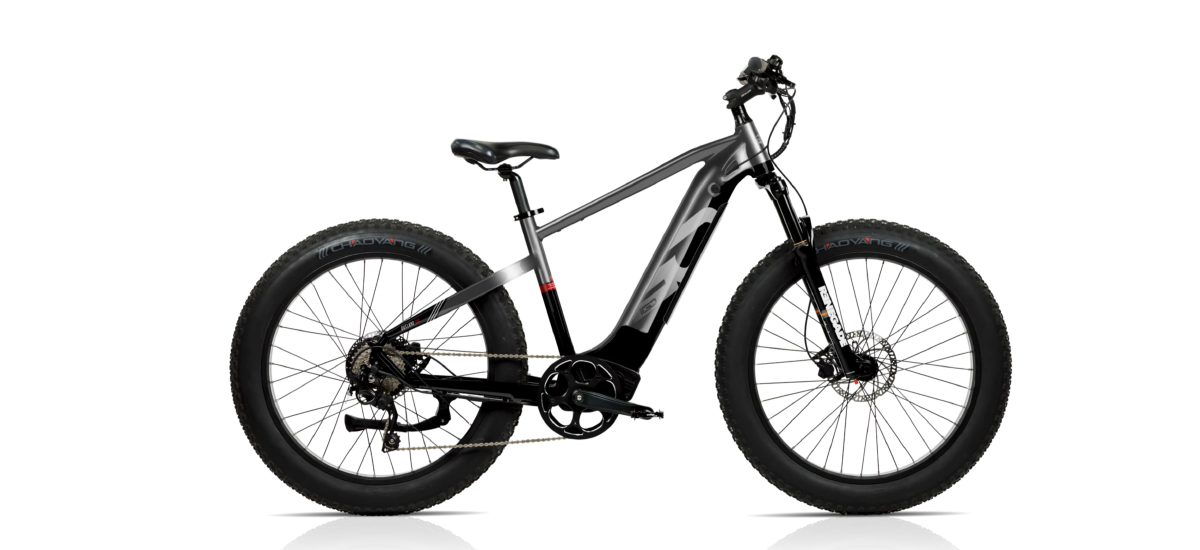
A serious contender off-road and on
Check Best Price | Full Review Coming Soon
Many fat-tire e-bikes, particularly those in the more affordable price range under $3,000, toe the line between capable commuter and sturdy mountain bike. They’ve got one foot in each world.
iGo’s Outland-Oka is an exception to this rule, and for (well) less than $3,000 is a well-spec’d and well-designed fat-tire electric mountain bike built for trail riding. Equipped with a 500W Bafang torquey rear hub motor and 672Wh battery integrated into the frame, the motor’s power nor the bike’s 57 lbs won’t overwhelm the rider in tighter, more technical terrain. It’s also equipped with a 120mm air fork from RST Suspension, a SRAM X5 9-speed drivetrain and solid Tektro Auriga hydraulic disk brakes.
Bear in mind that fat bikes are a special breed of mountain bike that aren’t quite as maneuverable or nimble as their skinny-tire counterparts, but they’re extremely fun in their own right (especially when you add a motor into the equation). But bikes like this truly shine on snow or soft terrain, which might explain why a Canadian company like iGo built a bike like the Outland-Oka.
If you’re looking for a fat-tire e-bike that’ll let you explore some more serious singletrack trails, the Outland-Oka may be worth looking at.
- It’s lighter than your average fat-tire e-bike, has a paired down frame and is spec’d with more aggressive components, making this a uniquely capable and affordable fat electric mountain bike.
- The 672Wh battery balances nicely with the 500W motor, giving the bike a solid range.
- iGo also has their own mobile app, called iGo Connect that lets you track lots of metrics including speed, motor performance and change modes from your phone.
- The RST air fork is better than a spring fork, but still might be a little light duty for heavy trail riding.
Biktrix Juggernaut Classic
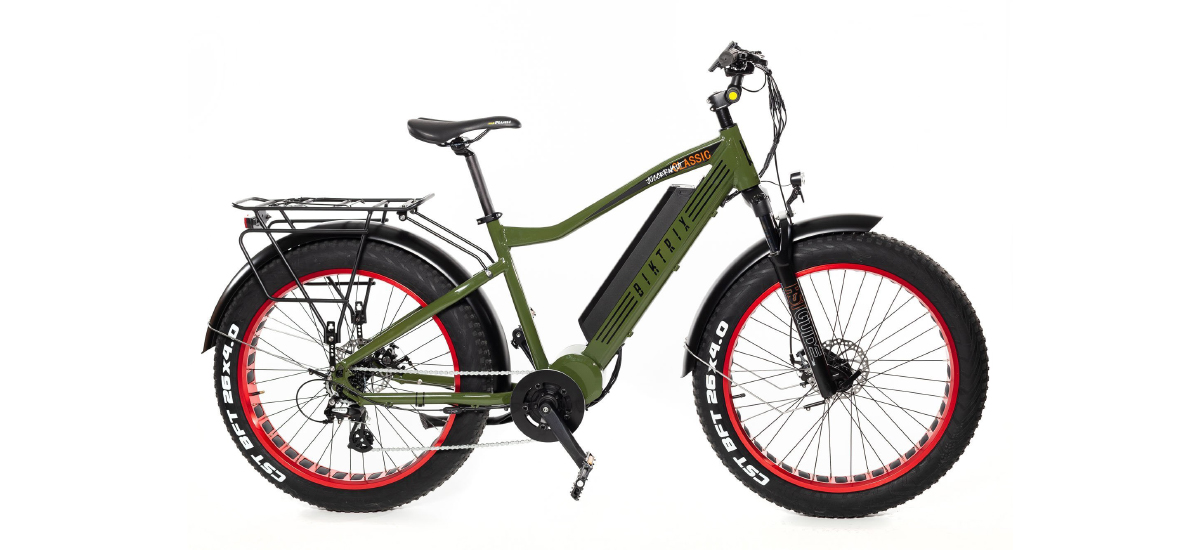
An affordable and powerful mid-drive option
Check Best Price | Full Review Coming Soon
The Biktrix Juggernaut Classic is bucking the idea that mid-drive electric bikes have to be expensive. At (substantially) less than $3,000, this 750W fat e-bike has all the power characteristics of an expensive mid-drive bike but for half the price.
The motor is the tried-and-true Bafang BBS02 750W mid-drive that, in the stock configuration, is powered by a sizable 840Wh semi-integrated battery. But, for an additional cost, you can upgrade that battery to a whopping 1,032Wh unit that will keep the bike rolling for quite a while. The bike ships with Tektro hydraulic disc brakes, a SunRace 8-speed drivetrain and an RST Guide suspension fork, but you can upgrade the brakes to an even more powerful set from Magura.
The Juggernaut comes with all the accoutrements you’d expect from a fat-tire e-bike, including a rear rack and fenders, lights and a nice display, but it’s the motor on this bike that really sets it apart. We’ve spent some time on bikes equipped with 750W Bafang mid-drives and have been really impressed with how torquey and powerful they are.
This is a great option for a person looking to get an affordable and powerful fat-tire mid-drive electric bike.
- You don’t often find such powerful mid-drive motors on bikes this cheap. It’s an impressive amount of power for such little investment.
- The bike is thoughtfully outfitted with racks, fenders and a chain guard, making this bike commute ready
- The stock 840Wh battery is impressive on its own, but the optional 1,032Wh upgrade gives this bike a seriously impressive range. That much energy nicely balances the bike’s big motor.
- The SunRace drivetrain is not particularly common and its durability and performance not well documented. A more mainstream drivetrain would have been nice, and luckily SunRace is compatible with Shimano components.

A premium fat-tire e-bike built by hunters for hunters
Check Best Price | Full Review Coming Soon
Built around one of the most powerful mid-drive motors currently available, the Bakcou Storm is a full suspension fat e-bike designed and built by hunters and outdoorspeople for hunters and outdoorspeople.
Think of the Storm as the proverbial kitchen sink of electric bikes. Short of a folding mechanism (which would be crazy on a bike like this), this thing is sporting pretty much every sought-after feature you can think of: It’s a full suspension, has an uber-powerful mid-drive motor, 4-inch tires, the option for a monster battery, hydraulic disk brakes and much more.
Aside from the optional camouflage paint job (you can also order it in more traditional colorways), the Storm’s hunting and backcountry ethos is most obvious in its motor. Bakcou outfitted this bike with a Bafang Ultra mid-drive motor, which is capable of laying down 1,000W continuously. This amount of power is overkill for most riders, but is an important feature for hunters and other backcountry users who may need to pull a heavy trailer or have their bike laden with gear. That power can be easily toggled between the 1,000W max setting and 750W, which makes it easy for the rider to keep the bike compliant with local laws and regulations depending on where they are riding. Powering that motor is a stock 835.2Ah battery, or you can upgrade to a 1,008Wh battery for extended range.
In the burgeoning world of hunting e-bikes, there’s few more capable than the Bakcou Storm. It’s a quiet,capable and rugged option for those looking to get into the backcountry and back without disturbing wildlife or using a combustion engine.
Bakcou also gets some extra credit for being a Utah-based company. As fellow Utahns, the EBR staff are suckers for anything else made or conceived of in the Beehive State.
- Users can easily toggle between 750W and 1,000W motor settings, making it easy to comply with local e-bike laws and regulations depending on where they’re riding
- You don’t often see full suspension fat e-bikes, and Backcou is making a good effort to do it right. Especially in the rear suspension, which boasts a RockShox Monarch shock.
- The Bafang Ultra motor is one of the most powerful production mid-drive motors money can buy. If you’re concerned about power and torque, you won’t be after trying this bike.
- The Storm is only available in a 19-inch frame size, which limits who can ride it. It’d be great to see a bike at this price point come in multiple frame sizes.
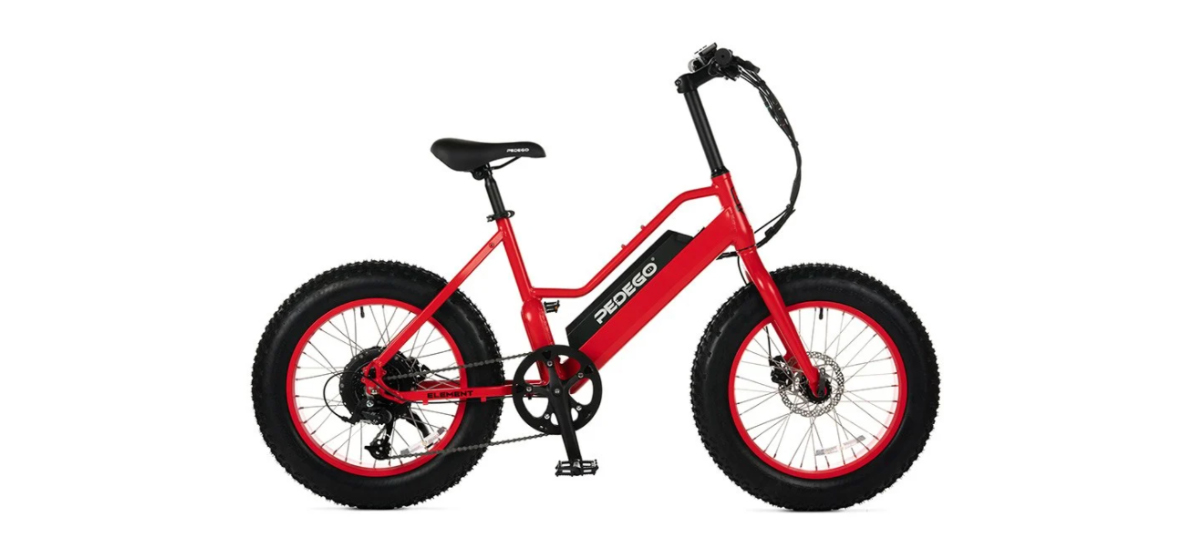
A small(ish) and easy to ride fat e-bike from a well known brand
Check Best Price | Full Review Coming Soon
The Pedego Element is a compact and easy to ride fat-tire electric bike from one of the oldest and most recognizable e-bike brands in the U.S.
The Element is a smaller stature fat bike with 20-inch tires and a more compact 17-inch mid-step frame, which makes it a bit easier to handle and get on. The bike is built around a 500W rear hub motor powered by a 480Wh battery and shifting is predominantly handled by Microshift with a few Shimano components thrown in there. The brakes are Shimano Altus mechanical disk brakes with 160mm rotors and the 4-inch tires are from Kenda and closely match the tread pattern on the Krusade model, though Pedego doesn’t specify which Kenda tires they are.
Though the bike comes in one size, which is roughly similar to a medium in most other bikes, it’s got a remarkably tall steerer tube that makes the fit easily customizable to lots of different body sizes and shapes. Pedego bikes are also backed up by the brand’s sizable network of brick-and-mortar dealers dotted all over the country. Not only does this make it easy to test ride an element before you buy, it means you’ve likely got a knowledgeable mechanic nearby if your bike needs work down the road (like a car, bikes need periodic maintenance too).
Pedego is one of the oldest and most trusted U.S. e-bike brands and their Element fat-bike is not only a great fat bike, but it also happens to be the cheapest bike in their whole lineup. If you’re looking for a capable Pedego, look no further.
- With a mid-step frame and an overall compact design, the Element is easy to handle and easy to get on and off of.
- The smaller wheel diameter (though this is technically a full-sized bike) makes the fat tires slightly easier to handle, especially in corners.
- It’s hard to understate the importance of Pedego’s network of dealers — this is hugely helpful should you need service or have questions.
- The Element is only available in a 17-inch frame size, which can be limiting for larger riders.
A budget fat e-bike with components that won’t let you down
Check Best Price | Full Review Coming Soon
With a 500W motor and a low entry price of a little over $1,000, the Sondors X is a capable and inexpensive fat-tire e-bike.
It sports ultra-wide 4.9 inch tires and the 500W motor is powered by a sizable 840Wh battery. That battery is mounted inside a triangular box inside the front triangle of the frame, which is a bit of a signature look from Sondors. It’s got a Shimano 7-speed drivetrain, mechanical disc brakes and weighs in at about 67 lbs. It does not have a suspension fork, which isn’t super uncommon at this price point, but those nearly 5-inch wide tires will provide a surprising amount of suspension when set to the right pressure.
Sondors prides itself on the affordability and quality of their e-bikes. They’re committed to building affordable but durable electric transportation, and that pledge is evident in the X. It’s not the fanciest or best-decked e-bike we’ve seen, but it will get the job done and won’t let you down.
It’s a great option for the fat-tire rider on a budget.
- The 840Wh battery is surprisingly big for this affordable of a bike. Paired with the 500W motor, that gives you a pretty exceptional range.
- Nearly 5-inch tires were a smart choice, considering this bike has no suspension. Set them to the appropriate pressure and those will smooth out bumpy surfaces
- The X is a one-size-fits-all bike, which can be a little limiting for tailoring the fit to particularly large or small riders.
Bottom line: Fat tires have made e-bikes more approachable
Few of the bikes on this list will likely ever tread into the truly difficult terrain fat bikes were originally designed for, and that’s OK.
The hunting e-bikes are an exception to that statement, but by and large, your average fat-tire e-bike rider probably isn’t picturing slop, sand and snow as their ideal day out on the bike. Most of these bikes will live their lives putting in miles on paved paths, gravel roads and maybe some very light-duty trails. So why choose fat tires over a traditional bicycle tire? The answer is simple: Because they feel more stable and are more confidence inspiring, especially to newer riders or those venturing off-road for the first time.
E-bikes have made bicycles far more accessible and appealing to people who before never thought of swinging a leg over a human-powered machine, and that’s a wonderful thing. But these new bike riders have lots of questions and maybe even reservations about traction, capability and whether or not they’ve got enough contact with the ground to keep themselves tire-side-down in corners or under hard braking. Fat tires help with that.
Sure, there’s a whole contingent of outdoorspeople who have very real concerns about floatation and traction, and companies like Bakcou and QuietKat have delivered bikes that’ll romp through the backcountry with abandon. But by and large, your average fat e-bike rider just wants to feel secure on their bike. Or, if we’re being totally honest, they just think the big tires look really cool (we do too).
Whether you’re a backcountry enthusiast, a rider looking for the feeling of stability or a person who just thinks the big tires look cool, you’ve come to the right place.
Related
Reader Interactions

Source link








